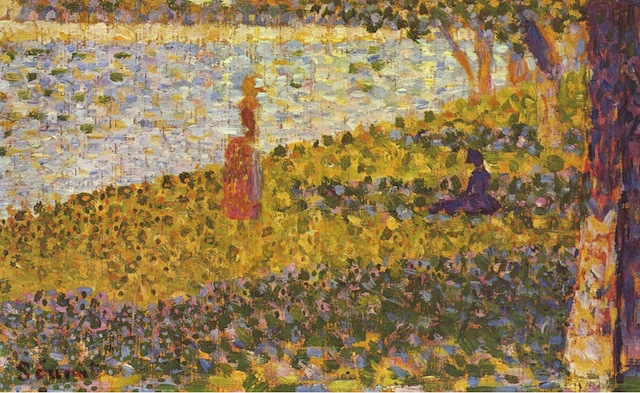Georges Seurat (1859 – 1891) was the inventor and only transcendent practitioner of pointillism–the rendering of form in dots of pigment rather than free-flowing brushstrokes and fields of color.


Seurat was most successful with this method on a fairly small scale, where he produced images that have a subtly colored and immensely lively surface that unifies foregrounds and backgrounds, positive and negative shapes–as in these two examples.
The tradeoff is that the size of the dots swallows detail. Shapes must be kept simple if they are not to dissolve and disappear.
If lack of detail is a problem, the fix is to make the piece larger, so that each square inch describes a smaller part of the design. That works, up to a point. But as the piece gets larger and larger, and the dots stay the same size, the dots get lost. And since vivacity and intricacy of surface is the reason for using dots in the first place, the whole enterprise becomes self-defeating.
The study below hints at the problem. The right side and foreground, where the shapes and dots are large, is elegant and suggestive. As we go left, and into the distance, the rigor of the dots is lost. The handling gets niggly because Seurat is planning out the detail he intends for the final, full-size version. For example, compare the crimped woman in red at the left edge with the similar figure in “By the Seine” above. And in order to describe the sailboat in the distance he must abandon the pointillist touch entirely.
- Seurat – study for “A Sunday on La Grande Jatte” 26×33″ 1884 (W’ped)
The problems get worse in the enormous final version, which pushes pointillism beyond its capacity. Allowance must be made for the fact that this is a photo: the original is grayer and duller, the colors are less intense, the darks not so hamfisted. But at a distance where you can see the whole thing, the dots disappear. The simplified shapes that were so subtle and lively in the study are now merely mannered and inert. Background and foreground cohere now, but the effect is one of visual busyness and technical diligence, without excitement.

I should say that Seurat was the only transcendent practitioner until Chuck Close ( b. 1940 ), whose small pieces, especially, have a similar vitality.

